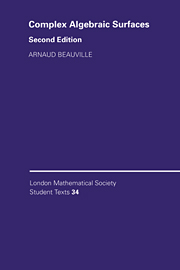Book contents
- Frontmatter
- Contents
- Introduction
- Notation
- Chapter I The Picard group and the Riemann–Roch theorem
- Chapter II Birational maps
- Chapter III Ruled surfaces
- Chapter IV Rational surfaces
- Chapter V Castelnuovo's theorem and applications
- Chapter VI Surfaces with pg = 0 and q ≥ 1
- Chapter VII Kodaira dimension
- Chapter VIII Surfaces with k = 0
- Chapter IX Surfaces with k = 1 and elliptic surfaces
- Chapter X Surfaces of general type
- Appendix A Characteristic p
- Appendix B Complex surfaces
- Appendix C Further reading
- References
- Index
Chapter I - The Picard group and the Riemann–Roch theorem
Published online by Cambridge University Press: 18 March 2010
- Frontmatter
- Contents
- Introduction
- Notation
- Chapter I The Picard group and the Riemann–Roch theorem
- Chapter II Birational maps
- Chapter III Ruled surfaces
- Chapter IV Rational surfaces
- Chapter V Castelnuovo's theorem and applications
- Chapter VI Surfaces with pg = 0 and q ≥ 1
- Chapter VII Kodaira dimension
- Chapter VIII Surfaces with k = 0
- Chapter IX Surfaces with k = 1 and elliptic surfaces
- Chapter X Surfaces of general type
- Appendix A Characteristic p
- Appendix B Complex surfaces
- Appendix C Further reading
- References
- Index
Summary
Unless otherwise stated, we consider surfaces with their Zariski topology (the closed subsets are the algebraic sub varieties); ‘sheaf’ will mean ‘coherent algebraic sheaf’. This is a matter of convention: Serre's general theorems ([GAGA]) give a bijection between algebraic and analytic coherent sheaves which preserves exactness, cohomology, etc. All our arguments with coherent algebraic sheaves will remain valid in the analytic context.
Fact I.1 The Picard group
Let S be a smooth variety. Recall that the Picard group of S, Pic S, is the group of isomorphism classes of invertible sheaves (or of line bundles) on S. To every effective divisor D on S there corresponds an invertible sheaf Os(D) and a section s ∈ H0(Os(D)), s ≠ 0, which is unique up to scalar multiplication, such that div(s) = D. We define Os(D) for an arbitrary D by linearity. The map D → Os(D) identifies Pic S with the group of linear equivalence classes of divisors on S.
Let X be another smooth variety and f : S → X a morphism. We can define the inverse image with respect to f of an invertible sheaf, to get a homomorphism f* : Pic X → Pic S. If f is surjective, then we can also define the inverse image of a divisor, in such a way that just note that the inverse image of a non-zero section of OX(D) is non-zero.
- Type
- Chapter
- Information
- Complex Algebraic Surfaces , pp. 1 - 10Publisher: Cambridge University PressPrint publication year: 1996



